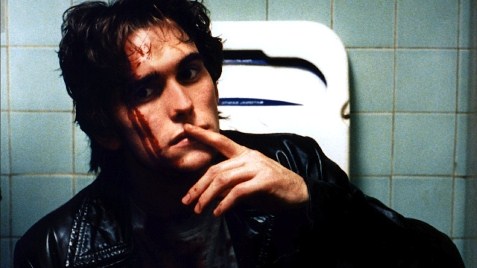Hidden Netflix Gems: Drugstore Cowboy
This week’s Hidden Netflix Gem: “Drugstore Cowboy” (1989)
“Drugstore Cowboy” became director Gus Van Sant’s breakthrough film following its release in 1989. The film was critically acclaimed, ending up on both Gene Siskel and Roger Ebert’s lists of the top ten films of the year. Today, its rating stands at 100 percent on the Tomatometer. Of course, aggregators like Rotten Tomatoes can be inaccurate for older films, but in this instance the site takes 27 reviews into account. Van Sant went on to receive Academy Award nominations for Best Director for his work on “Good Will Hunting” (1997) and “Milk” (2008).
But back to “Drugstore Cowboy.” The film stars Matt Dillon as Bob Hughes, the leader of a gang of drug addicts travelling the Pacific Northwest in the early 1970s and doing just about anything to get a fix (generally of pharmaceutical opiates, for reasons that will become clear in a moment). Bob’s crew is made up of his wife, Dianne, who’s played by Kelly Lynch, his partner Rick (James Le Gros), and Rick’s new girlfriend, Nadine, who’s played by a 19 year-old Heather Graham. The cast also includes James Remar as Gentry, a police officer whose relationship with Bob is somewhat reminiscent of Ricky and Julian’s interactions with Park Supervisor Jim Lahey in “Trailer Park Boys” (which you know about if you’ve been keeping up with my “Hidden Netflix Gems“). And I can’t not mention that one of the film’s best scenes comes from a cameo by prominent author (and junkie) William S. Burroughs as Tom, a man who’s “shot a million dollars in his arm.” Oh, and who just so happens to be a priest.
The film is fantastic overall, but what really makes it special is its realistic portrayal of addicts and addiction. In no way does “Drugstore Cowboy” glorify drug use, but neither is it repentant in its frank depiction. “This is what it is, all of it,” the film seems to say, asking neither for your sympathy nor your approval, only your attention. “Drugstore Cowboy” delves into the minds and bodies of its addicted characters, examining what it feels like to need a fix as well as some of the underlying issues that might cause one to turn to drugs and the lifestyle that their use can (but does not necessarily) lead to in the first place. “Most people don’t know how they’re gonna feel from one moment to the next,” Bob explains, “but a dope fiend has a pretty good idea. All you gotta do is look at the labels on the little bottles.”
One thing that might not seem so realistic is the way Bob and his gang generally go about getting their fix: robbing pharmacies, hospitals, and hospital pharmacies. Then again, we’re looking at it from a 21st century perspective, with all the technological advancement that entails, whereas in the 70s it seems all you needed was a distraction and someone who could pick a lock. Another tally in the realism column comes from the fact that the film is based on a semi-autobiographical novel of the same name by James Fogle. I know what you’re thinking, there’s a reason it’s a semi-autobiographical novel, and even if it was non-fiction, it’d be easy for the author of such a book to lie, especially considering said book wasn’t even published until a year after the film was released. But then there’s this. It seems Fogle’s still at it. He was arrested in 2010 for attempting to, well, steal money and narcotics from a pharmacy in suburban Seattle. Yes, two thousand ten. It was a brilliant marketing campaign for a book/movie more than two decades old. Yeah, that or the man just needed a fix.
The crew keeps on keeping on, running around robbing and getting high for a while. But when tragedy strikes (that’s all I’ll say to avoid spoilers, watch the damn movie), Bob decides he wants to go straight. The time he spends trying to get clean and avoiding the traps of his former lifestyle make up some of the film’s best scenes.
Interspersed with all this darkness and addiction, “Drugstore Cowboy” does have more than its fair share of humorous moments. There’s Bob’s continuous torment of Officer Gentry (there’s a reason it reminded me of the comedic genius that is “Trailer Park Boys”), and of course the times Bob gets to discussing hexes. He’s a very superstitious man, this Bob Hughes. When Rick mentions dogs, he gets a scolding, and we (along with the character) learn from Bob that such a thing brings about a 30-day curse. When Rick tries to justify his statement by explaining that Bob had never told him not to mention dogs, Bob responds, “The reason nobody mentioned dogs, Rick, is that to mention the dog would have been a hex in itself.” And don’t even get him started on leaving hats on beds. That’s 15 years bad luck, maybe even death.
The film showcases brilliant direction from Van Sant, as well as a then 25 year-old Dillon in one of the best performances of his long career. When you find out what the tragedy is or why mentioning dogs is so awful, well, those scene really demonstrate both the actor and the film’s emotional range. As the movie runs its course you’ll find yourself on the edge of your seat, laughing, and perhaps even empathizing with one of those “low-down lousy junkies” for a moment, even if you’ve never touched a beer or a joint, let alone a needle, in your life. “Drugstore Cowboy” brings to the table a gritty realism that is uncommon not just in films about drug use but in films, period. I can think of few better ways to spend 101 minutes on a Saturday evening than enjoying this breakthrough masterpiece.
Check out the trailer below and follow the writer on Twitter @NateKreichman.
It’s Saturday night and you need something to watch. Never fear, Hidden Netflix Gems is a weekly feature designed to help you decide just what it should be, and all without having to scroll through endless pages of crap or even leave the house. Each choice will be available for streaming on Netflix Instant, and the link below will take you to its page on the site. Look for a new suggestion here every Saturday.
Related Posts
Comments Off on Hidden Netflix Gems: Drugstore Cowboy
Posted in: Entertainment, Movies
Tags: Bob Hughes, Dianne Hugues, Drugstore Cowboy, Gus Van Sant, Heather Graham, Hidden Netflix Gems, James Fogle, James Le Gros, James Remar, Kelly Lynch, Matt Dillon, Nadine, Narcotics, Nate Kreichman, Rick, Staff Picks - Movies, Trailer Park Boys, War on Drugs, William S. Burroughs









